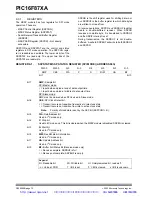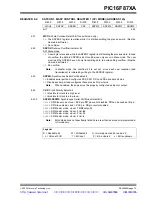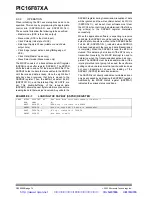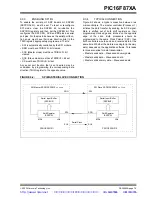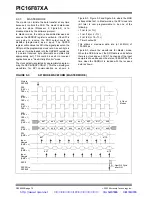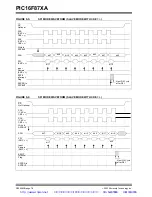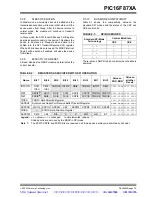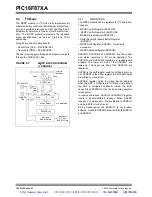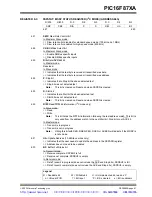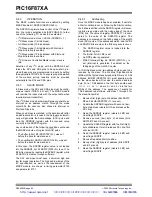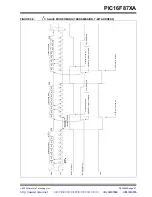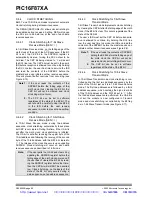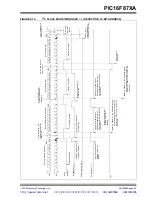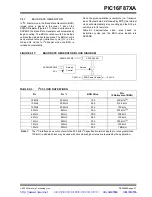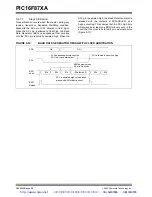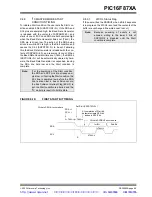
PIC16F87XA
DS39582B-page 84
2003 Microchip Technology Inc.
9.4.2
OPERATION
The MSSP module functions are enabled by setting
MSSP Enable bit, SSPEN (SSPCON<5>).
The SSPCON register allows control of the I
2
C opera-
tion. Four mode selection bits (SSPCON<3:0>) allow
one of the following I
2
C modes to be selected:
• I
2
C Master mode, clock = OSC/4 ( 1)
• I
2
C Slave mode (7-bit address)
• I
2
C Slave mode (10-bit address)
• I
2
C Slave mode (7-bit address) with Start and
Stop bit interrupts enabled
• I
2
C Slave mode (10-bit address) with Start and
Stop bit interrupts enabled
• I
2
C Firmware Controlled Master mode, slave is
Idle
Selection of any I
2
C mode, with the SSPEN bit set,
forces the SCL and SDA pins to be open-drain, pro-
vided these pins are programmed to inputs by setting
the appropriate TRISC bits. To ensure proper operation
of the module, pull-up resistors must be provided
externally to the SCL and SDA pins.
9.4.3
SLAVE MODE
In Slave mode, the SCL and SDA pins must be config-
ured as inputs (TRISC<4:3> set). The MSSP module
will override the input state with the output data when
required (slave-transmitter).
The I
2
C Slave mode hardware will always generate an
interrupt on an address match. Through the mode
select bits, the user can also choose to interrupt on
Start and Stop bits
When an address is matched, or the data transfer after
an address match is received, the hardware automati-
cally will generate the Acknowledge (ACK) pulse and
load the SSPBUF register with the received value
currently in the SSPSR register.
Any combination of the following conditions will cause
the MSSP module not to give this ACK pulse:
• The buffer full bit, BF (SSPSTAT<0>), was set
before the transfer was received.
• The overflow bit, SSPOV (SSPCON<6>), was set
before the transfer was received.
In this case, the SSPSR register value is not loaded
into the SSPBUF, but bit SSPIF (PIR1<3>) is set. The
BF bit is cleared by reading the SSPBUF register, while
bit SSPOV is cleared through software.
The SCL clock input must have a minimum high and
low for proper operation. The high and low times of the
I
2
C specification, as well as the requirement of the
MSSP module, are shown in timing parameter #100
and parameter #101.
9.4.3.1
Addressing
Once the MSSP module has been enabled, it waits for
a Start condition to occur. Following the Start condition,
the 8 bits are shifted into the SSPSR register. All incom-
ing bits are sampled with the rising edge of the clock
(SCL) line. The value of register SSPSR<7:1> is com-
pared to the value of the SSPADD register. The
address is compared on the falling edge of the eighth
clock (SCL) pulse. If the addresses match, and the BF
and SSPOV bits are clear, the following events occur:
1.
The SSPSR register value is loaded into the
SSPBUF register.
2.
The Buffer Full bit, BF, is set.
3.
An ACK pulse is generated.
4.
MSSP Interrupt Flag bit, SSPIF (PIR1<3>), is
set (interrupt is generated if enabled) on the
falling edge of the ninth SCL pulse.
In 10-bit Address mode, two address bytes need to be
received by the slave. The five Most Significant bits
(MSbs) of the first address byte specify if this is a 10-bit
address. Bit R/W (SSPSTAT<2>) must specify a write
so the slave device will receive the second address
byte. For a 10-bit address, the first byte would equal
‘
11110 A9 A8 0
’, where ‘
A9
’ and ‘
A8
’ are the two
MSbs of the address. The sequence of events for
10-bit address is as follows, with steps 7 through 9 for
the slave-transmitter:
1.
Receive first (high) byte of address (bits SSPIF,
BF and bit UA (SSPSTAT<1>) are set).
2.
Update the SSPADD register with second (low)
byte of address (clears bit UA and releases the
SCL line).
3.
Read the SSPBUF register (clears bit BF) and
clear flag bit SSPIF.
4.
Receive second (low) byte of address (bits
SSPIF, BF and UA are set).
5.
Update the SSPADD register with the first (high)
byte of address. If match releases SCL line, this
will clear bit UA.
6.
Read the SSPBUF register (clears bit BF) and
clear flag bit SSPIF.
7.
Receive Repeated Start condition.
8.
Receive first (high) byte of address (bits SSPIF
and BF are set).
9.
Read the SSPBUF register (clears bit BF) and
clear flag bit SSPIF.
http://www.xinpian.net
提供单片机解密、IC解密、芯片解密业务
010-62245566 13810019655



